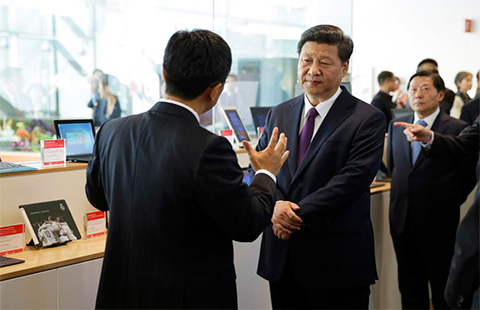Xinjiang has become an information society. Six decades ago telegrams and post were mainly carried by animals. Now, its communications industry has entered the modern information era. There is Internet coverage across most of the region. In 2014, broadband user numbers exceeded 3 million, and there were 91 mobile phones per 100 people. Around 98 percent of villages had phone line connections and 97 percent of administrative villages had broadband connections. Xinjiang has invested great efforts in raising the status of Urumqi as a regional inward and outward hub in international telecommunication services. Its voice and data services have cross-border connections with more than ten foreign countries, and are able to connect international call services to the whole of the country.
Solid progress has been made in opening up to the outside world. Since 1978, Xinjiang, with state approval, has created 17 first-class ports and 12 second-class ports, in addition to successfully holding 19 Urumqi Foreign Economic Relations and Trade Fairs and four China-Eurasia Expos. It has set up two national economic development zones in Kashi and Khorgos, and the International Center for Cross-Border Cooperation between China and Kazakhstan in Khorgos. Now, there are in Xinjiang 23 state-class industrial clusters. It trades with 186 countries and regions. A new pattern of all-round opening up has taken shape in the region. The value of Xinjiang's combined imports and exports grew from US$51 million in 1955 to almost US$27.7 billion in 2014, averaging an annual growth rate of 11.3 percent. Between 2009 and 2014, applied foreign investment grew at an annual rate of over 12 percent, the volumes of overseas contract business increased by an annual average of 26 percent, and investment outside China went up by an annual average of 25 percent.
The driving force of scientific and technological innovation has remarkably increased in Xinjiang's socio-economic development. Since its founding, Xinjiang has experienced constant increases in its financial input in science and technology, in the size of staff in scientific work, in the variety research platforms and in the number of research achievements, which have gradually led to the establishment of a system of scientific and technological innovation with distinct regional characteristics. The contribution made by scientific and technological progress to the development of agriculture has increased year by year, and improved crop varieties make up over 90 percent of total output. Industrial technology and new and high technology are developing rapidly. Xinjiang leads the country in railway traction transformer technologies, solar and wind power equipment research and manufacturing, and information processing in ethnic minority languages. It has made major technological breakthroughs in the field of resources and environment technology, discovering the petroleum and natural gas reserves in the Tarim Basin. The technologies used in the Tarim Desert Highway and Shelter Forest Project meet the highest international advanced standards.
Steady progress has been made in environmental protection. The ecological system in Xinjiang is extremely fragile, with very limited environmental capacity. Oases account for only 5 percent of the region's total area. Over the past 60 years, and especially since 2010, Xinjiang has made ecological and environmental protection a top priority, insisting on sustainable development of resources and the eco-environment. It has devoted great efforts to protecting and building its ecological system, carefully balancing the interests of economic growth and environmental protection.

 Here's what's on the menu for the state dinner
Here's what's on the menu for the state dinner
 President Xi visits Microsoft campus in Seattle
President Xi visits Microsoft campus in Seattle Xi revisits Lincoln High School after 1993 bond
Xi revisits Lincoln High School after 1993 bond
 Chinese, US business leaders gather at roundtable meeting
Chinese, US business leaders gather at roundtable meeting Xi visits assembly line of plane manufacturer Boeing in US
Xi visits assembly line of plane manufacturer Boeing in US First Lady tours Fred Hutchson Cancer Research Center
First Lady tours Fred Hutchson Cancer Research Center
 Boeing to sell 300 planes to China
Boeing to sell 300 planes to China Sino-US ties need more understanding: Xi
Sino-US ties need more understanding: Xi















